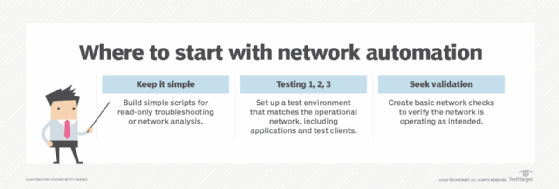
iconimage - Fotolia
What is network automation, and what can it do for you?
This feature explores what network automation is and its influence on organizations. It also discusses assumptions about its effect on network engineers and similarities with SDN.
No, automation won't replace network engineers or take their jobs away. However, network automation could change their responsibilities.
The word automation can refer to various different IT capabilities, but what is network automation specifically? Network automation involves automating network processes, such as configuration, management and testing of network devices. Network automation also plays a large role in modern networking capabilities, such as software-defined networking (SDN) and network virtualization. Overall, this automation aims to minimize the potential for human error and simplify network operations.
This compilation explores what network automation is, as well as various tools, risks and use cases of the approach. Explore these five common questions and answers about network automation.
What is network automation's real risk, and how can you avoid it?
The idea of network automation can cause wariness among network professionals. If small changes can result in network failures, then network teams may not want to risk a large change like automation. Yet, like all technologies, network automation has both benefits and risks, which might not always balance each other out, said Terry Slattery, principal architect at NetCraftsmen.
Network teams can simplify network automation by implementing standardized network designs instead of complex designs, Slattery said, as teams can more easily maintain streamlined, standard designs. Simple designs and automated tasks can help teams avoid major risks, such as network outages, as teams can learn the functions of network automation tools and test these functions before fully adopting network automation.
Learn more about network automation risks and tasks.
What are three common use cases for network automation?
Network automation tools can improve configuration deployment, accuracy, operations efficiency and maximize use cases for organizations. Those use cases include device provisioning, information gathering and configuration compliance validation, according to Phillip Gervasi, a network engineer. Overall, network automation minimizes the likelihood of human error and improves network efficiency and agility.
The use case around device provisioning refers to configuration changes for network devices. With network automation, for example, multiple devices can receive changes simultaneously. Information gathering typically involves the Simple Network Management Protocol, which hasn't scaled well in modern networks, Gervasi said, but new streaming telemetry could simplify this. Validating configuration compliance with automation improves configuration changes before they roll out to network devices.
Dive further into network automation use cases.

How are automated network configuration and management changing?
Network teams can automate any network resource controlled through a command-line interface (CLI), which is how teams traditionally entered configurations. Automated network configuration aims to simplify the task of entering CLI instructions, according to Dan Conde, an independent analyst. Intent-based networking, or IBN -- a networking approach that uses machine learning and AI to automate a network's administrative tasks -- can also simplify these tasks.
However, organizations may not feel ready to embrace IBN yet due to its immaturity. Still, conventional change management tools can manage current configurations and archive old configurations. New network verification tools and automated tools can help with important network areas, such as design, implementation and testing, Conde said.
Read more about automated network configuration and management.
What is network automation's best tool or service?
Decisions about network automation tools depend on an organization's resources and capabilities. In some cases, automated scripts can benefit network teams that prefer to build their own services rather than buy new tools. One disadvantage of automated scripts, however, is they can consume teams' time, Conde said, as time spent developing scripts could impede time spent on other aspects of network management.
Writing manual, CLI-based scripts can cause errors, and it requires team members to have coding skills and may not scale as efficiently as some organizations need. This plan is better suited to teams with enough resources to invest in the effort. Alternatively, organizations that can't afford to invest in custom scripts could adopt vendor services, though these tools are less flexible than customized services.
Explore more insight into network automation tools.
Are SDN and network automation the same?
No, SDN and network automation are not the same, though they are often mistaken for one another. This confusion is due to how useful network automation is in software-defined settings, according to Andrew Froehlich, president of West Gate Networks. Automation can improve SDN, but organizations don't need SDN for network automation.
One benefit of SDN is increased visibility of network infrastructure and applications from a central location. Network teams can easily automate network tasks with the centralized control plane. Another SDN benefit for automation is increased routing intelligence, as SDN can incorporate AI analytics that can help efficiently automate data traffic routing.
See more about the relationship between SDN and network automation.








